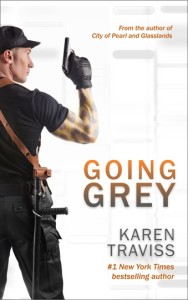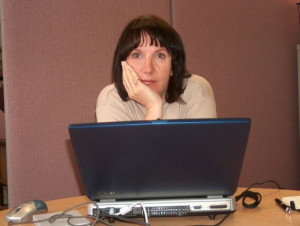A guest blog by Karen Traviss
 Some day – maybe not today, maybe not tomorrow, but soon, as the man said – you might find yourself wondering why suddenly nothing you write seems to come alive on the page.
Some day – maybe not today, maybe not tomorrow, but soon, as the man said – you might find yourself wondering why suddenly nothing you write seems to come alive on the page.
I don’t mean writer’s block. You’re still churning stuff out, knowing where you need to go, but when you read it back to yourself it feels flat and lifeless, regardless of the amount of information that you’ve imparted to the reader. It’s hard to put your finger on it: there’s nothing actually wrong with it. All you know is that it just doesn’t fly.
Sometimes walking away from it for a couple of weeks is all you need to see it with new eyes, but you might not have the luxury of time, or it might be a symptom of a broader problem, that you’ve run out of creative juice. It’s not that you don’t know where to take the story next: it’s just that you can’t see a better way of telling it.
There are always different ways to tell the same story. Only you know whether your current version is “wrong” – trust your judgement the way a painter or musician does instead of assuming an outsider will know better – and one size doesn’t fit all. But one way of finding alternatives is to learn from the techniques of other media. Take your troublesome story, chapter, or scene, and see how it works as a comic, movie, or game.
I’m a visual thinker. I have to “translate” my books from mental movies into descriptions and transcriptions. I write comics and games as well as novels, and when I get an idea for a story, my first question is which medium would suit it best. But I’d take a guess that most novelists never write anything but prose fiction or essays, and many don’t read comics or play games, so they’re not used to applying images to story. My advice probably sounds useless: how can you learn anything by doing what you don’t know how to do and don’t even consume? But if you think of yourself as just a writer and reader, you almost certainly watch TV and movies as well. You can use those instead. You already know more than you think.
Take a scene or a few chapters of your manuscript and jot down a summary of what happens. hen imagine that extract as scenes in a movie or pages of a comic. (Grab a video or find a comic in a similar genre and take a look at it first if you’re not sure where to begin.) Then sketch a storyboard of your novel excerpt – stick figures and lollypop trees will do fine – and see what lends itself to images and what doesn’t. And fill those panels with every object you think will be there, even if you haven’t mentioned it in the manuscript. Your brain will probably rush to fill empty spaces anyway. It’s very good at show-not-tell.
You don’t have to get it right. You’ll have clunky transitions, and panels or shots that you just don’t know how to fill, but those gaps will be equally useful in understanding how you can bring your story alive. When you need images that grab the eye, you’ll realise that maybe you need to start the intro with a guy wandering around a museum and being moved on by the staff because he spends so long in there, and ditch the opening where he’s just sitting in his room while he ponders how much he loves history. Just write in what you’re trying to convey in any gap and go back to it later.
Now take a look at the finished storyboard, gaps and all. Does it turn out to be all talking heads because the characters aren’t anywhere specific or doing anything that adds to the story? Do they move around in interesting and relevant settings? Are there objects in their field of view that add information when examined, a portrait on the wall or a warning sign, like discoverables in games? Does the scene end on a dramatic image with an implied “To be continued” panel like a comic? Find your gaps and visually boring sequences, and from those filled gaps, more ideas will flow.
The opening line to this essay is, as I hope most of you know, from the movie Casablanca. Whatever film you use as a crash course in visual grammar to pep up your manuscript, don’t pick that one. The irony is that one of the greatest films of all time is, when you analyse it, almost all talking heads, very few locations, nearly all interiors, and almost no action. But with a great cast, a cracking script, and a solid story, you can get away with it. Just not this time.
Part II: Learning To Take Risks.

New York Times best-selling author Karen Traviss is a former journalist and has also spent way too much of her life around politicians and police. Going Grey, the first in her new techno-thriller series, and the sequel, Black Run, are available now.
Twitter: @karentraviss
